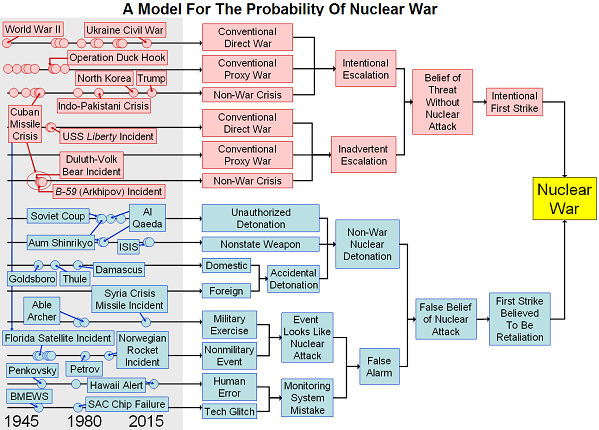(First published on Stoke.)
On 5th November 2018, India announced that its (partially) indigenously designed and built nuclear-powered ballistic missile submarine, INS Arihant returned from its “deterrence patrol,” completing India’s nuclear triad of land, air and sea based nuclear delivery systems. Media responded with reporting about it as a “historic achievement” and an “accomplishment.”
I talked with Hans Kristensen of Swedish International Peace Research Institute (SIPRI) and the director of Nuclear Information Project about this development, who recently published the details of Indian nuclear forces in the journal of Bulletin of the Atomic Scientists. The interview can be found at the bottom of the article.
Dangers of thermo-nuclear weapons, from a single detonation to a full blown war are numerous and could be terminal for organized human life on the planet. Even a limited exchange of 4 or 5 warheads between India and Pakistan will lead to millions of deaths, total collapse of agriculture, radioactivity in whatever water resources will be left, countless sick and mimed with severely destroyed medical infrastructure and the collapsed political structures. Nuclear weapons modernization and even a conventional arms race is contrary to the logic of deterrence and increases security risks. Also, the research, production, maintenance and up-gradation of these weapons are projected to take up trillions of dollars in the coming decade. Most human would consider holding civilians of other nations and our own nation hostage for apparent security morally reprehensible and it could soon become illegal under international law.
Despite all these risks and costs involved, missing from the media landscape was any critical voice talking about these anomalies in international politics, at a time when most of the nation states are calling for its total ban and scientific community is sounding alarm about terminal nuclear disaster. All these risks were set aside by the simple act of omission and the weapons of mass destruction that “pose a grave threat to international, national and human security”, in words of UN Secretary-General António Guterres, were normalized and in fact praised.
Here are some of the headlines:
“INS Arihant enhances India’s security needs” – Business Standard.
“Sea change: INS Arihant marks a high in India’s strategic independence. But it is just the beginning” – Indian Express.
“India completes nuclear triad with INS Arihant’s first patrol” – Hindustan Times.
“The significance of Arihant”, Indian Express. By Former Naval Chief Arun Prakash.
“India achieved a significant milestone in its strategic nuclear posture” (IE) was the dominant theme established in the national coverage.
In this article I will first look at INH Arihant within the context of Indian nuclear posture and review the relevant risk research around nuclear weapons and war.
Indian Nuclear Forces.
India is one of four nuclear weapon states (NWS) that are not a signatory of the Treaty on the Non-Proliferation of Nuclear Weapons (NPT), a treaty that has support of 190 nation states. India has also not signed the Comprehensive Nuclear-Test-Ban Treaty (CTBT), the treaty has not yet gotten into force because India, North Korea and Pakistan have not signed and China, Egypt, Iran, Israel and the United States have not ratified it. In September 2017 Treaty on the Prohibition of Nuclear Weapons (TPNW) opened for signatures and ratification. 69 states have signed the Treaty and 19 have ratified it – India has so far not taken part in any process. It will come into force after 31 more parties ratify – which is expected to be around 2020. India with handful of other NWSs stands in splendid isolation in a world opposing the bomb. And if the TPNW comes into force it will be deemed a criminal state under international law.
By latest estimates India has sufficient fissile material for 150-200 nuclear warheads and has produced 130-140 warheads.

The Arun Prakash column in Indian Express reminded us that the nuclear modernization project will take up trillions of rupees in coming years, which only a small part of conventional military modernization drive that is estimated to take over 6 Lakh Crore by 2025 alone. India’s budgetary allocation for health, education and other social expenditure is 1.3 Lakh Crore in 2018-19 while we spent over 4 Lakh Crore on Defense. INS Arihant alone costed around 1 Lakh Crore to the Indian citizens. More over the overall social and opportunity costs of military spending include manpower and infrastructures devoted to war related activities rather than towards social needs. Spending trillions on potentially criminal and unimaginably devastating weapons at cost of education, climate mitigation and adaptation technologies, health and public transportation should raise some concerns over the concept of “national pride.”
In January 2018, The Hindu revealed that INS Arihant was severely damaged by a human error that damaged the propulsion system. The authors of the article also made the revelation that “[t]he absence of Arihant from operations came to the political leadership’s attention during the India-China military standoff at Doklam. Whenever such faceoff takes place, countries carry out precautionary advance deployment of submarine assets”. (INS Arihant left crippled after ‘accident’ 10 months ago, The Hindu, January 08, 2018)
This suggests India might have deployed nuclear weapons against China during the Doklam stand-off. This non-war conflict could have lead to a situation of inadvertent escalation and a perception of nuclear threat or false alarm could have lead to a detonation and probably a substantial nuclear exchange.

It is already doubtful whether the national security state provides any meaningful security (even in the limited sense of the word) to its population from external threats – state and non-state, with its preparation of war and disregard for diplomatic and peaceful settlements and reconciliations and cooperation. It also puts into question whether the deterrence “theory” is even tangible within the processes of national security state. Deterrence presumes rational decision making, which includes diplomacy and peaceful settlements – threatening postures and rhetoric run contrary to the deterrence framework. Hans Kristensen in the interview said that, “[t]he Arihant in its current configurations does not enhance India’s deterrent posture in a meaningful way”.
Under the UPA regime, too, there were no breakthroughs in India-Pakistan diplomatic relations but under the NDA the relations have broken-down. The cross-border exchange of mortars and bullets has increased with more intensity between the Indian and Pakistani forces. India Pakistan border remains a major hotspot for potential nuclear war. Kristensen in the interview noted that, “Nuclear parity is not essential but significant asymmetry can deepen mistrust and trigger worst-case planning that speeds up the arms race and make a future crisis very unstable”.
In conclusion to this section, within the international nuclear political arena India is isolated but as all the other rogue states that are also disregarding international norms and consensus are most powerful nations the tension and risks continue to build-up with every new technological development, conflict and missed diplomatic opportunities.
Nuclear Risks.
Risks of nuclear weapons in Indian context can be divided into roughly two categories. First a significant nuclear exchange and second a single nuclear detonation. The first kind of scenario could arrive from a number of possible trajectories. A false alarm, a missing nuclear submarine (there are a number of cases where this has happened) in a war or peace time situation. Technical errors and human errors could also trigger a nuclear detonation. A single detonation could happen by accident during deployment of a warhead or a terrorist attack.
Karthika Sasikumar, in a paper described predictable consequences of a limited nuclear exchange between India and Pakistan.
“Exploding a 20-kiloton bomb (the equivalent of the “Fat Man” bomb dropped on Nagasaki, Japan) over Hyderabad, India, produces around 436,000 immediate fatalities. The fatality estimates depend on, among other things, the time of day that the detonation takes place. If the explosion was to be near the surface rather than in the air, the casualties would be halved, but the bomb would produce devastating radiation over 13 square kilometers.
With an airburst detonation, which would maximize damage to buildings, Hyderabad would lose nearly 150 medical facilities (based on Google Maps designations, which might not be completely accurate).
The famine that would result could affect more than a billion people, according to a 2012 briefing paper by physician Ira Helfand. Using a model of the global economy, the paper found that a regional nuclear war between India and Pakistan would cause malnutrition among 215 million people across the world over a decade and would also put at risk the 925 million people who are already chronically malnourished. Helfand’s estimate for the number of people who would be added to the rolls of the malnourished is on the lower side, since it assumes that markets continue to operate normally.
There is less than one hospital bed per 1,000 residents in India and Pakistan (The World Bank Undated). Even in India’s capital, only 1.4 beds are available per thousand residents. Interestingly, the major hospitals in New Delhi are located very near the administrative center of the city, a potential Ground Zero discussed above. Experts believe that civil defense will be extremely difficult to implement in India and Pakistan.
In the event of an attack by Pakistan, India’s sizable Muslim minority (approximately 170 million) could face retaliation from the Hindu majority, triggering communal riots.” (Karthika Sasikumar (2017) After nuclear midnight: The impact of a nuclear war on India and Pakistan, Bulletin of the Atomic Scientists, 73:4)
The consequence of a substantial exchange would be termination of all organized human life and of many ecosystems. (2018 Doomsday Clock Statement Science and Security Board)
In conclusion, the consequences of nuclear weapons are beyond anything justifiable and are potentially terminal for our species. The costs of developing and maintaining these weapons are immense. Possession of nuclear weapons might soon become illegal, which will make India a criminal state. Disregarding NPT, CTBT and TPNW already gives weight to the argument that India and other NWSs are acting as rogue states. When Indian mainstream media chooses to omit all these important fact and praise the weapons, responsibility of nuclear disasters – including end of human life – also fall on their shoulders.
Interview with Hans Kristensen.
Sarthak: How do you see this development? Would you say it is “an achievement”?
Hans Kristensen: For sure, it is an achievement because India has spent decades and billions on developing this capability. We still don’t know much about the submarine actually did during the patrol and whether it actually carried nuclear warheads on the missiles at the time. If it did carry nuclear weapons, it would be a significant change in India’s nuclear warhead management, which has so far avoided deploying warheads on missiles under normal circumstances.
S: Does INS Arihant and conventional modernization generally enhance India’s “deterrence credibility”?
HK: The Arihant in its current configurations does not enhance India’s deterrent posture in a meaningful way. For it to play any role, it would have to sail deep up into the Arabian Sea for its missiles to be able to reach important targets in Pakistan, or sail all the way into the South China Sea to be able to hit targets in China. It is doubtful that Pakistan or China currently have the capability to preemptively decapitate India’s land-based deterrent. Once Indian SSBNs in the future are equipped with longer-range missiles, then the sea-based force will begin to play a really role in India’s posture. For now, I consider the Arihant a technology-development project intended to improve the capability and develop operational and command and control procedures and technologies to be able to operate an SSBN force effectively in the future.
S: What nuclear development do you predict in the coming years in the region?
HK: India and Pakistan both seem intent on continuing their bilateral arms race with development and deployment of more nuclear weapons. While Pakistan is focused on India, the Indian planning is spending more efforts on improving its posture via-a-vis China. In the immediate future, both India and Pakistan will deploy new and longer-range ballistic missiles and begin to field nuclear-capable cruise missiles. Pakistan has already begun to develop tactical nuclear weapons; India not so much although its Prithvi II could be counted as such. Pakistan does not have the capability of building an SSBN fleet but is developing nuclear cruise missiles for its attack submarines. Once Indian SSBNs begin to patrol the Indian Ocean, we will likely see Chinese and Pakistani navies trying to develop anti-submarine capabilities and strategies to find the submarines and be able to hold them at risk in a war. Likewise, India will now have to enhance its capabilities to protect its missile submarines. This will add a new expensive and potentially dangerous dynamic to the arms race and military competition in the region.
S: What are the risks associated with a nuclear submarine like Arihant?
HK: As mentioned above, once a country deploys SSBNs, its adversaries will try to find them so they can hunt them in a war. That raises risks for accidents and incidents in peacetime and for escalation or misunderstandings during a crisis or war. Imagine if a serious crisis or a war erupted with Pakistan and the Indian navy suddenly lost contact with a deployed SSBN. Would Indian authorities conclude that this was a technical glitch or that the submarine had been sunk by Pakistan? Likewise, since Pakistan does not have the capability to build an SSBN fleet, will it now conclude that India is trying to outpace it by building a nuclear force where the land-based weapons are intended to destroy much of Pakistan in a first strike, where India’s future missile defense system would scoop up the few remaining Pakistani warheads that have survived, and the Indian SSBNs would be intended to give India the ability to win a nuclear war? Nuclear parity is not essential but significant asymmetry can deepen mistrust and trigger worst-case planning that speeds up the arms race and make a future crisis very unstable.




